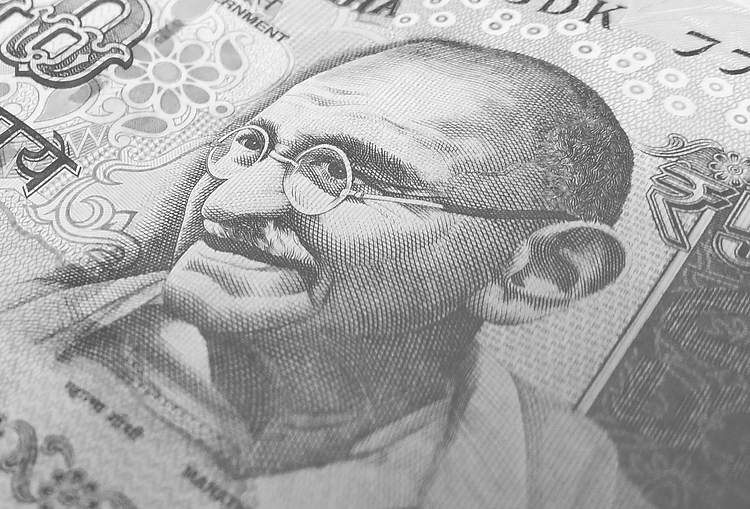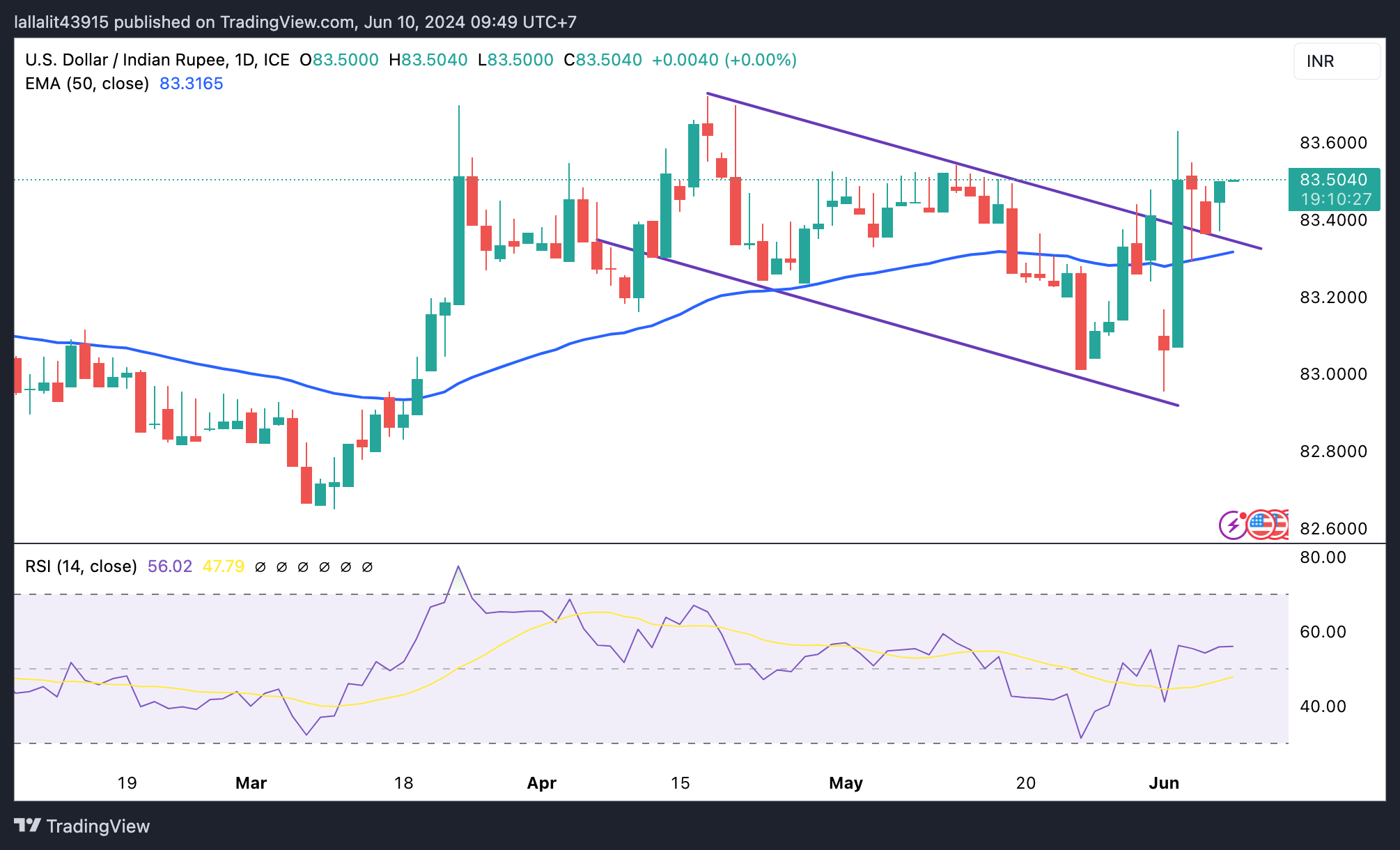- Indian Rupee trades flat on Monday amid the stronger US Dollar.
- The lower bets on the Fed rate cuts and Indian foreign outflows might underpin the pair.
- The Indian and US Consumer Price Index (CPI) for May will be due on Wednesday.
Indian Rupee (INR) trades on a flat note on Monday despite the rebound of Greenback. The positive outlook of India’s resilient economy and financial stability could provide some support to the INR. However, the robust US employment data for May pared back rate cut expectations from the Federal Open Market Committee (FOMC) might boost the US Dollar (USD) against the INR. Additionally, foreign investors have net sold Indian shares worth 422.81 billion rupees since March, contributing to the Indian Rupee’s weakening.
Investors will monitor the formation of the new government as Narendra Modi was sworn in Sunday for a third consecutive term as India’s Prime Minister. India’s Consumer Price Index (CPI) will be released on Wednesday. On the US docket, the CPI inflation report will be published on Wednesday ahead of the FOMC rate decision on Thursday.
Daily Digest Market Movers: Indian Rupee trades sideways amid mixed sentiment
- The Indian rupee is stable and inexpensive compared to its emerging market peers, making it a favorite for carry traders, said David Hauner, head of global EM fixed-income strategy at Bank of America.
- The Reserve Bank of India’s (RBI) Monetary Policy Committee (MPC) kept the repo rate unchanged at 6.5% in its June meeting.
- The RBI revised upwards the GDP growth projection for the current fiscal year to 7.2% from 7.0% on rising private consumption and revival of demand in rural areas.
- RBI governor Shaktikanta Das said that although India has contained inflation while keeping its economy growing, food inflation remains a concern.
- The Labor Department showed on Friday that the US economy created far more jobs than expected in May, which dampened the expectation that the US Fed will start cutting interest rates in September.
- The US Nonfarm Payrolls (NFP) climbed 272,000 in May from a 165,000 increase (revised from 175,000) in April and came in above the forecast of 185,000, the Labor Department showed on Friday.
- The Unemployment Rate ticked up to 4.0% in May from 3.9% in April. Meanwhile, wage inflation, as measured by the Average Hourly Earnings, rose 4.1% YoY in May from 4.0% (revised from 3.9%) in April, above the market consensus of 3.9%.
- Futures traders are now pricing in nearly 49% odds of a rate cut for the September meeting, down from 68% before the NFP data, according to the CME FedWatch tool.
Technical analysis: USD/INR keeps the bullish picture above the 100-day EMA
The Indian Rupee trades stronger on the day. The bullish outlook of the USD/INR pair remains intact above the descending trend channel upper boundary and the key 100-day Exponential Moving Average (EMA) on the daily chart. Further consolidation mode looks favorable since the 14-day Relative Strength Index (RSI) hovers lower towards the 50-midline.
Stronger bullish momentum past 83.55 (high of June 5) might lift the pair up to 83.72 (high of April 17) en route to the 84.00 major psychological mark
On the other hand, the resistance-turned-support level and the 100-day EMA at the 83.30–83.35 region act as an initial support level for USD/INR. Any follow-through selling might drag the pair to the 83.00 round level, followed by 82.78 (low of January 15).
US Dollar price today
The table below shows the percentage change of US Dollar (USD) against listed major currencies today. US Dollar was the weakest against the Australian Dollar.
| USD | EUR | GBP | CAD | AUD | JPY | NZD | CHF | |
| USD | 0.10% | 0.06% | 0.03% | -0.10% | 0.10% | -0.01% | 0.15% | |
| EUR | -0.09% | -0.04% | -0.07% | -0.21% | 0.00% | -0.12% | 0.05% | |
| GBP | -0.07% | 0.04% | -0.03% | -0.17% | 0.03% | -0.09% | 0.09% | |
| CAD | -0.04% | 0.07% | 0.03% | -0.14% | 0.08% | -0.05% | 0.11% | |
| AUD | 0.12% | 0.24% | 0.19% | 0.14% | 0.20% | 0.09% | 0.27% | |
| JPY | -0.08% | 0.03% | -0.02% | -0.06% | -0.19% | -0.11% | 0.05% | |
| NZD | 0.02% | 0.11% | 0.07% | 0.04% | -0.08% | 0.11% | 0.17% | |
| CHF | -0.14% | -0.05% | -0.08% | -0.12% | -0.25% | -0.05% | -0.15% |
The heat map shows percentage changes of major currencies against each other. The base currency is picked from the left column, while the quote currency is picked from the top row. For example, if you pick the Euro from the left column and move along the horizontal line to the Japanese Yen, the percentage change displayed in the box will represent EUR (base)/JPY (quote).
Indian Rupee FAQs
The Indian Rupee (INR) is one of the most sensitive currencies to external factors. The price of Crude Oil (the country is highly dependent on imported Oil), the value of the US Dollar – most trade is conducted in USD – and the level of foreign investment, are all influential. Direct intervention by the Reserve Bank of India (RBI) in FX markets to keep the exchange rate stable, as well as the level of interest rates set by the RBI, are further major influencing factors on the Rupee.
The Reserve Bank of India (RBI) actively intervenes in forex markets to maintain a stable exchange rate, to help facilitate trade. In addition, the RBI tries to maintain the inflation rate at its 4% target by adjusting interest rates. Higher interest rates usually strengthen the Rupee. This is due to the role of the ‘carry trade’ in which investors borrow in countries with lower interest rates so as to place their money in countries’ offering relatively higher interest rates and profit from the difference.
Macroeconomic factors that influence the value of the Rupee include inflation, interest rates, the economic growth rate (GDP), the balance of trade, and inflows from foreign investment. A higher growth rate can lead to more overseas investment, pushing up demand for the Rupee. A less negative balance of trade will eventually lead to a stronger Rupee. Higher interest rates, especially real rates (interest rates less inflation) are also positive for the Rupee. A risk-on environment can lead to greater inflows of Foreign Direct and Indirect Investment (FDI and FII), which also benefit the Rupee.
Higher inflation, particularly, if it is comparatively higher than India’s peers, is generally negative for the currency as it reflects devaluation through oversupply. Inflation also increases the cost of exports, leading to more Rupees being sold to purchase foreign imports, which is Rupee-negative. At the same time, higher inflation usually leads to the Reserve Bank of India (RBI) raising interest rates and this can be positive for the Rupee, due to increased demand from international investors. The opposite effect is true of lower inflation.

